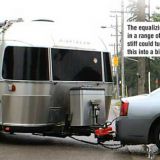
What Can You Tow with Your Family Car?
Your RV dealer can help you select a variety of trailers to match most family vehicles.
For many years, new RV enthusiasts have asked me to explain why some family cars are suitable for trailer towing while others may not be an appropriate choice.
This letter appeared in my email a few days ago and it inspired a very interesting exercise in setting up a trailer/tow vehicle combination.
Dear Andy,
I recently enjoyed watching an episode of The Nature of Things that showed an Airstream Trailer being towed by a Volkswagen Diesel. We have often thought that RV travel would appeal to our minimalist lifestyle but we did not think it would be possible with some of the cars that we like to drive.
Currently, we drive a Mini that we really love – in fact, it is our second one. We found your website and saw pictures of a Mini towing an Airstream. Our Mini does not have the Turbo Charger and we have a manual transmission. Could we tow a trailer with our Mini?
Often, two vehicles with very similar appearance can have drastically different towing capabilities. The Mini is a good example. We have only setup one Mini to tow travel trailers so we don’t have tons of experience with it but the one we outfitted for towing does offer a lot of insight.
There are three engines available in Minis – the naturally aspirated model that our reader has and two turbo charged engines. The Mini we towed with was quite powerful with 208 hp and 192 ft/lb of torque. It also had a 6-speed manual transmission. This Mini has the power to tow an aerodynamic full-size trailer.
Though it is a small car, the wheelbase and stance are quite large for its size and the overhang is only 22% of the wheelbase. The suspension is extremely tightly controlled and firm riding – the car handles like it’s on rails.
We took some video footage of the combination and we were quite amazed that when going around the entrance ramp the Tahoe we were using as a camera car could not corner as fast as the Mini could with the Airstream. This Mini and trailer combination performed very well and although we did not measure it in the slalom course, I am pretty certain it is the best handling tow vehicle/RV combination I have ever driven and just a great deal of fun.
Hitching the Family Car
Let’s continue the discussion of towing with the family car by explaining how a Mini (or a wide range of family sedans) can handle a travel trailer.
To tow this size and weight trailer we have to use a weight equalizing hitch that spreads the tongue weight of the trailer to all four wheels of the car. If you were to attach a trailer of this size to the rear of a car that does not have an equalizing hitch, the trailer tongue and the rear of the car would be several inches below level – making the combination difficult to handle, if not dangerous on the road.
When we hitched the trailer to the weight distributing hitch that we installed on the Mini, and used the equalizing bars to lever some of the trailer tongue weight onto the front axle, the Mini’s suspension was pushed down ½” front and rear by the trailer’s 400 lbs of hitch weight. This resulted in a level combination of tow vehicle and trailer; essential for optimal steering, braking and stability of the rig.
Similar application of the principles of weight equalization may be applied to a full range of tow vehicles and travel trailers.
In order to use weight distribution, you need a Class 3 receiver which is distinguished by a 2” square receiver opening. While many hitch manufactures offer kits for the installation of Class 3 equalizing hitches to a variety of popular family cars, there is no standard bolt-on Class 3 hitch available for a Mini. So for this application, we had to custom build a hitch receiver that would withstand the torque of the weight distribution bars.
In the case of the reader’s Mini, we would build a Class 3 receiver suitable to handle a small Airstream. However, if the car’s engine only produces 121 horsepower and 114ft/lb of torque, it would not have enough power to pull the Airstream through the air so building a hitch this heavy-duty would likely be a waste of time and money.
You can purchase a fairly easy to install Class 1 receiver for the Mini. Class 1 hitches are rated for 2000 lb trailers with less than 200 lbs of hitch weight – suitable for towing some of the smaller travel trailers or a fold-down camping trailer.
On some vehicles with long rear overhangs and/or soft suspensions, even 200 pounds of hitch weight without weight distribution can be too much. It is really a matter of leverage and the laws of physics. In the case of the Mini with its very short overhang, it would not be a problem. One proviso is that the hitch balls needs to be very close to the back bumper of the car – within 4”. This would seem to make sense and be easy to do but, on occasion, the ball mounts provided with Class 1 and 2 hitches are excessively long.
When properly equipped, you might be surprised to see the range of RVs that can be towed by today’s family cars. In many cases, you can tow a lightweight trailer with a small amount of aerodynamic drag such as a classic Trillium or Boler; some of the teardrop shaped trailers, and the lightest weight hardtop campers would also be viable. The key here is to put the hitch on the car first and test tow any trailer before you purchase it. Most RV dealers will be happy to help you out with this.
Whatever trailer you choose, it should have electric brakes – it is very important that the trailer can stop itself. Some of these ‘lite’ trailers have surge brakes which activate when the trailer coasts forward against the car. These brakes are not very effective but fortunately most RV dealers can change them to electric brakes if everything else about the trailer matches what you are looking for.
If we can leave the Mini example for a moment, let’s take a look at the lighter alternatives to the Class 3 equalizing hitch in a family car application. Class 2 hitches are rated up to 3500-pounds of total weight and 350-pounds of hitch weight. These hitches are generally a little stronger than a Class 1 (sometimes used for very light utility trailers) but they are not designed for weight distribution.
The concern is that the Class 2 hitches are available for a wide range of vehicles that should not be towing a 3500-pound trailer with 350 pounds of hitch weight without weight distribution. Usually, when you get to this weight range you should go to a Class 3 hitch with weight distribution.
Whenever you purchase a hitch receiver, I would suggest always going with the strongest receiver available. Even if you are only towing a 2500-pound trailer, the Class 3 receiver will have less flex for a smoother ride and it gives you the option to move up to a larger trailer without throwing away your receiver. Usually there is not a great deal of cost difference between the two hitch classes.
Somehow, I think if you love your car – especially if it is a Mini – you will also love the freedom that RV travel gives you. Starting with a trailer that matches your existing car is a very cost effective way to explore your future RV options.
Originally published in RV Lifestyle, Volume 41, No. 2.










